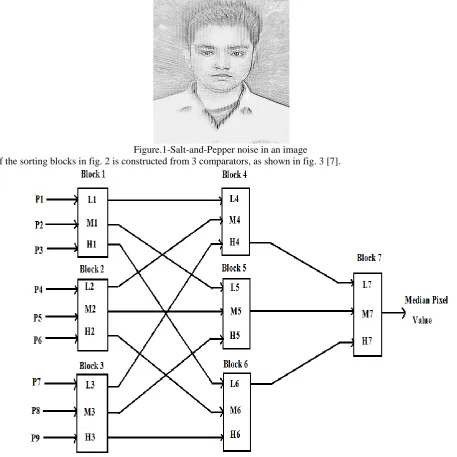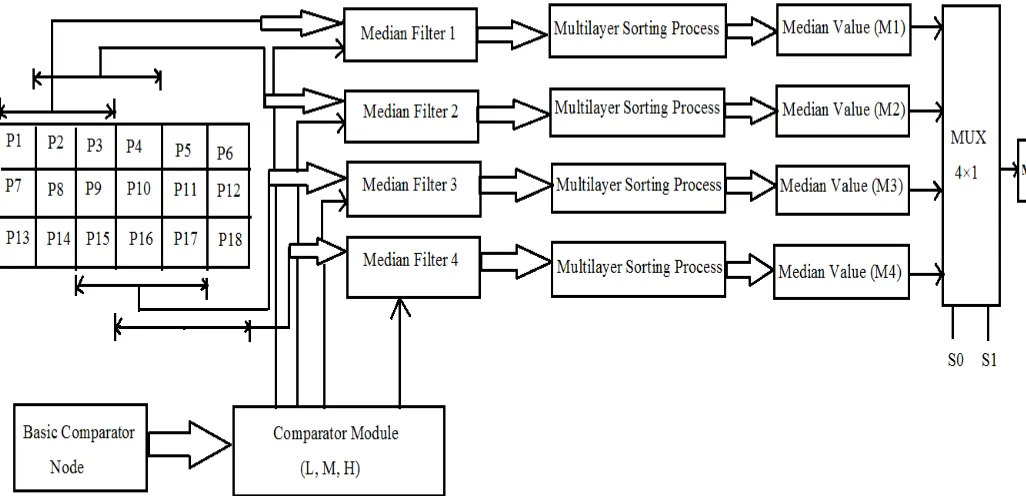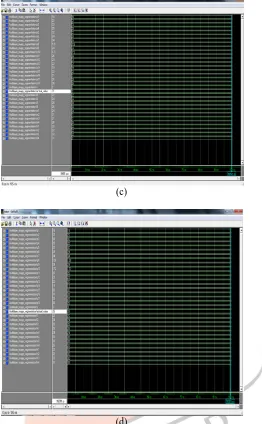IJEDR1502201
International Journal of Engineering Development and Research (www.ijedr.org)1216
Local Image Segmentation Process for
Salt-and-Pepper Noise Reduction by using Median Filters
1
Ankit Kandpal,
2Vishal Ramola,
1M.Tech. Student (final year), 2Assist. Prof. 1-2VLSI Design Department
1-2Faculty of Technology, University Campus, Uttarakhand Technical University, Dehradun, India
________________________________________________________________________________________________________
Abstract - There are various steps in image processing, which are used to improve visual standard of an image. Image segmentation is one of the most important step of them. The main objective of image segmentation is to extract various features of an image. This paper proposed the novel design of segmentation process for salt-and-pepper noise reduction by using median filters. The proposed design also describes the method for finding more median values in an image. The proposed structure has been designed and simulated on XILINX 8.1 tool in VHDL language.
Index Terms - Median filter, Salt-and-Pepper noise, Image segmentation, Multilayer sorting.
________________________________________________________________________________________________________
I. INTRODUCTION
Image segmentation is a very important image processing step and it has been used everywhere if we want to analyze what is happening inside the image. Image segmentation basically provides the meaningful objects of an image.
Image segmentation is a process of partitioning of an image into group of pixels which are homogeneous with respect to some criterion. Different groups must not intersect with each other and adjacent groups must be heterogeneous. The main objective of image segmentation is to extract various features of an image which can be merged or split in order to build objects of interest on which analysis can be performed. Image segmentation represents the first step in image analysis.
Basically noise in an unwanted thing which is directly affects the visual standard of an image. In many image processing application, it is necessary to smooth the noisy signals while at the same time preserving the edge information. The most commonly used smoothing techniques are liner filtering, average filtering, and median filtering. The linear filters smooth the noisy signals but also the sharp edges. In addition, the impulsive noise components cannot be suppressed sufficiently by linear filtering, and digital implementation of the linear filters can be bulky and slow. The averaging filters have some desirable features like outlier points that distort the filtered signal, and edge information loss. The median filters have proved to be good alternatives because they have some very interesting properties: 1) they can smooth the transient changes in signal intensity (e.g., noise); 2) they are very effective for removing the impulsive noise from the signals; 3) they can preserve the edge information in the filtered signal; and 4) they can be implemented by using very simple digital nonlinear operations. Because of these properties of the median filters, they are frequently used in various signal and image processing applications, such as seismic signal processing, speech processing, computerized tomography, medical imaging, robotic vision, pattern recognition, peak detection, coding, and communication [1].
In this paper we present an architecture based on local segmentation process for salt-and-pepper noise reduction by using median filter. The approach is implemented efficiently in hardware. It is based on partitioning of an image matrix in homogeneous mask. After that with the help of median filter we get the median values. These median values are different from the actual values. The size of these values (pixels) is nearly of the same as that of the remaining elements of the matrix. Now, these values are passed to a 4×1 MUX, with the help of MUX operation one can take single output at a time which is used to set the threshold o f an image. The motivation of our design is to gets good visual standard of an image.
The paper is organized as follows: in Section II, concept of median filter is reviewed. Subsequently, in section III, the proposed design of local image segmentation process for salt-and-pepper noise reduction by using median filter is presented. In section IV, the simulation results are given and discussed. Finally a conclusion will be made in the last section.
II. MEDIANFILTER
IJEDR1502201
International Journal of Engineering Development and Research (www.ijedr.org)1217
Median filters perform the following tasks to find each pixel values in the processed images: 1) all pixels in the neighborhood of the pixel in the original image which are identified by the mask are sorted in ascending (or) descending order. 2) the median of the sorted value is computed and is chosen as the pixel value for the processed image.There are various structures for implementing median 3×3 median filter [2-7]. We used the multilayer sorting algorithm structure [2] in our work. Multilayer implementation method has been proposed based on removing non-median pixels.
Figure.1-Salt-and-Pepper noise in an image
Each of the sorting blocks in fig. 2 is constructed from 3 comparators, as shown in fig. 3 [7].
Figure 2: Multilayer sorting of pixels [2]
Figure 2 contains 7 blocks and each block is assigned with three inputs. For block 1, the inputs are P1, P2, and P3. Now this block compares the inputs and gives low, medium and high value as output. For block 1, the outputs are L1, M1, and H1. The functionality of all the blocks is same. For block 2 and 3 the outputs are L2, M2, H2 and L3, M3, H3 respectively.
Block 4 feeds the low value of all the three previous blocks (B1, B2, and B3), compares them and drives the output as L4, M4, and H4. Block 5 feeds the medium value of three previous blocks (B1, B2, and B3), compares them and gives output as L5, M5, and H5. Block 6 feeds the high value of three previous blocks (B1, B2, and B3), compares them and drives output as L6, M6, and H6. The final block, block 7 is fed by three input i.e. high value of block 4 (H4), medium value of block 5 (M5) and low value of block 6 (L6). This block compares all of these values and extract out median value among them among all inputs applied.
IJEDR1502201
International Journal of Engineering Development and Research (www.ijedr.org)1218
Figure 3: Structure of a 3 pixel sorting block [7]III. PROPOSED ARCHITECTURE
Many kind of segmentation techniques have been presented previously [8-14]. However, they have a theoretical analysis of segmentation process. In this paper we proposed a local segmentation process structure for salt-and pepper noise reduction by using median filter. The structural diagram of this approach is shown in fig. 4.
Figure 4: Proposed architecture based on segmentation for noise reduction by using median filter
IJEDR1502201
International Journal of Engineering Development and Research (www.ijedr.org)1219
Figure 5: Problem matrixWe mentioned here this problem algorithm steps:- Step 1: Read an input image.
Step 2: To compute the median value of P8, we take 3×3 mask 1. Step 3: To compute the median value of P9, we take 3×3 mask 2. Step 4: To compute the median value of P10, we take 3×3 mask 3. Step 5: To compute the median value of P11, we take 3×3 mask 4.
(These 5 step process is called image partitioning or segmentation process)
Step 6: We feeds all masks in median filters 1, 2, 3, and 4 and finally we gets four median values through multilayer sorting process.
According to architecture (figure 4) here we have two options: 1) we replaced all median value in original image; 2) Or we can replace one median value in whole image according to threshold.
If we apply option 1 means all four median values, the pixel values which are very different from their neighboring pixels are replaced by equal to the neighboring pixel value. Hence, this process is capable of reducing salt-and-pepper noise.
Option 2 tells one more new concept in fig. 6. If user wants to set the threshold of an image matrix and wants a fix median value which is not greater than one value and not less than one value then with the help of MUX operation we can take one median value at one time among all four medians. The MUX operation is based on selection line conditions. This is shown in figure 6.
Figure 6: MUX operation of figure 4
IJEDR1502201
International Journal of Engineering Development and Research (www.ijedr.org)1220
M will be (M3) i.e. median value of third mask. When S0 and S1 are at (11), the output M will be (M4) i.e. median value of fourth mask.With the help of this concept, we can take one median value at one time among all four median values, in order to set the fix range threshold of an image which is required by the user.
IV. EXPERIMENTAL RESULTS
In this paper, we proposed a new structure and algorithm for salt-and-pepper noise reduction by using segmentation process and median filter. This algorithm exhibits suitability and simplicity for VLSI implementation due to regular architecture. We implement this proposed architecture in XILINX by using VHDL code. The RTL design hierarchy and simulation environment is summarized below:-
(A) RTL design hierarchy of proposed structure
The RTL design hierarchy is shown in figure 7.
(a)
(b)
IJEDR1502201
International Journal of Engineering Development and Research (www.ijedr.org)1221
(d)Figure.7: (a) RTL design hierarchy for full structure, (b) RTL design hierarchy of 4×1 MUX block, (c) RTL design hierarchy of multilayer sorting structure, (d) RTL design hierarchy of comparator block.
(B) Simulation results
The simulation result is shown in fig. 8. When we feeds mask 1 in median filter then we get the median value of this, similarly the process remains same for mask 2, 3 and 4. Finally we get four median values and we get the final output with the help of selection line conditions. Figure 8 shows condition wise simulation results.
(a)
IJEDR1502201
International Journal of Engineering Development and Research (www.ijedr.org)1222
(c)(d)
Figure 8 Simulation results (a) when selection line condition is (00), (b) when selection line condition is (01), (c) when selection line condition is (10), (d) when selection line condition is (11)
User can set one median value for full image by following selection line condition, or one can directly replace original value by median value. According to problem matrix in figure 5 we gets the median value of mask 1 = 24, median value of mask 2 = 31,median value of mask 3 = 31 and median value of mask 4 = 26. This is shown in fig. 11. When we take the median value, the pixel values which are very different from their neighboring pixels are replaced by a value equal to the neighboring pixel value. Hence, this approach is capable of reducing salt-and-pepper noise by using median filters.
Figure 9: Problem matrix with median values CONCLUSION
IJEDR1502201
International Journal of Engineering Development and Research (www.ijedr.org)1223
as a threshold. The threshold value expresses image brightness and darkness. In this paper we also described salt-and-pepper noise reduced by image partitioning. This new proposed structure is very effective for finding more median values in an image.REFERENCES
[1] Mustafa karaman, Levent Onural, and Abdullah Atalar, “Design and Implementation of a General-Purpose Median filter Unit in CMOS VLSI,” IEEE journal of solid state circuits vol. 25 no.2 1990.
[2] J. L. Smith, “Implementing Median Filters in XC4000E FPGAs”, XCell, Vol. 23, No. 4, 1996, p. 16. [Online].
[3] Tao Chen and Hong Ren Wu, “Space Variant Median Filters for the Restoration of Impulse Noise Corrupted Images”, IEEE Transactions on circuits and systems- II: analog and digital signal processing, Vol. 48, no. 8, august 2001.
[4] L. Breveglieri, V. Piuri, "Digital Median Filters", Journal of VLSI Signal Processing, Springer, pp. 191‐206, July, 2002. [5] Hakan Güray S¸ enel, Richard Alan Peters, “Topological Median Filters”, IEEE Transactions on image processing,Vol. 11, no. 2, February 2002.
[6] Alejandro Díaz-Sánchez, Jaime Ramírez-Angulo, Antonio Lopez-Martin, and Edgar Sánchez-Sinencio, “A Fully Parallel CMOS Analog Median Filter”, IEEE Transactions on circuits and systems- II: express briefs, vol. 51, no. 3, March 2004.
[7] Hossein Zamani HosseinAbadi, Shadrokh Samavi, Nader Karimi, “Low Complexity Median Filter Hardware for Image Impulsive Noise Reduction”, Journal of Information Systems and Telecommunication, Vol. 2, No. 2, April-June 2014.
[8] Shah Nilima, PatelDhanesh, JivaniAnjali, “Review on Image Segmentation, Clustering and Boundary Encoding”, International Journal of Innovative Research in Science, Engineering and Technology, Vol. 2, issue 11 november 2013.
[9] Miss Hetal J. Vala, Prof. Astha Baxi, “A Review on Otsu Image Segmentation Algorithm”, International Journal of Advanced Research in Computer Engineering & Technology (IJARCET) Volume 2, Issue 2, February 2013.
[10] A. M. Khan, Ravi. S, “Image Segmentation Methods: A Comparative Study”, International Journal of Soft Computing and Engineering (IJSCE), Volume-3, Issue-4, September 2013.
[11] Rajeshwar Dass, Priyanka, Swapna Devi, “Image Segmentation Techniques”, International Journal of Electronics & Communication Technology (IJECT), Vol. 3, Issue 1, Jan. - March 2012.
[12] Sujata Saini, Komal Arora, “A Study Analysis on the Different Image Segmentation Techniques”, International Journal of Information & Computation Technology, Volume 4, Number 14 (2014).
[13] Basavaprasad B, Ravi M, “A Comparative Study on Classification of Image Segmentation Methods with A Focus On Graph Based Techniques”, IJRET: International Journal of Research in Engineering and Technology, Volume: 03 Special Issue: 03 | May-2014 | NCRIET-2014.
[14] Muhammad Waseem Khan, “A Survey: Image Segmentation Techniques”, International Journal of Future Computer and Communication, Vol. 3, No. 2, April 2014.
Author’s Profile
Ankit Kandpal was born in June, 22, 1992 at Bageshwar, in India. He received his B.Tech. degree in Electronic and Communication Engineering from Uttarakhand Technical University, Dehradun (India) in 2012. He is currently pursuing M. Tech. (VLSI design) degree from Faculty of Technology, University Campus at the same university. His area of interests includes VLSI design, Advance digital signal processing, Digital image processing, and Nano scale device & circuit design.



